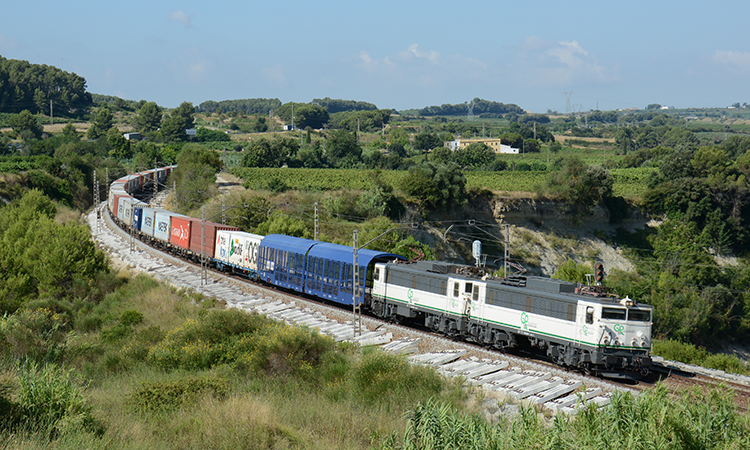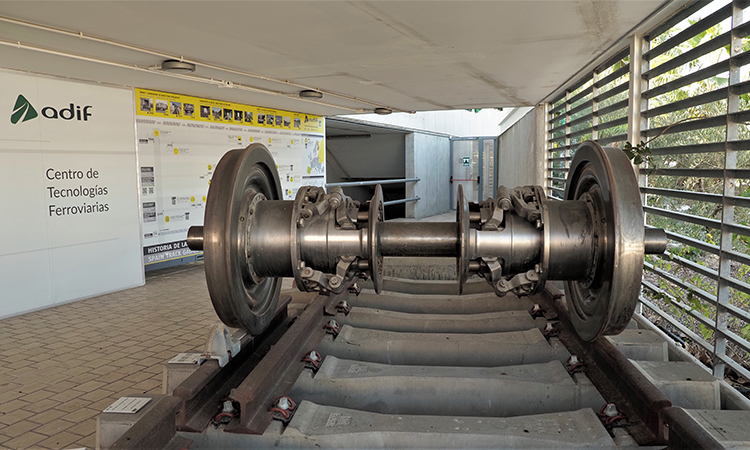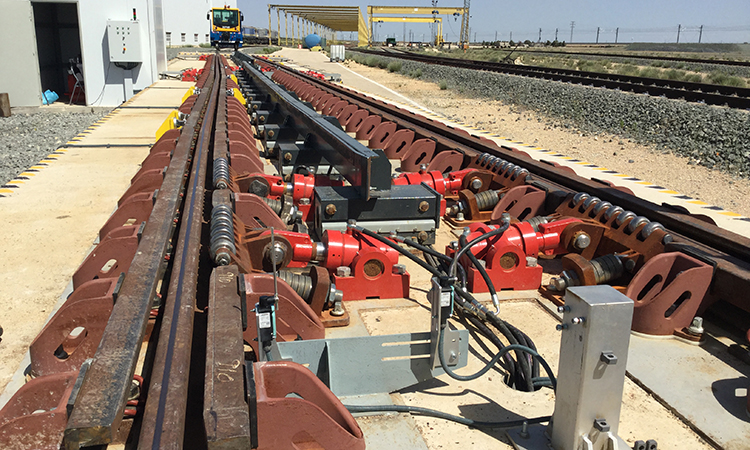The variable gauge system for freight trains in Spain
Posted: 8 June 2022 | José Conrado Martínez | No comments yet
José Conrado Martínez, Deputy Director of Strategic Innovation (CTO) of Adif, explains the difficulties caused by the gauge in Spain, as well as the rest of Europe, and how Adif are contributing to making railroad’s safer with a freight gauge changeover project.


At the end of the mandatory tests, the system obtained the approval of the axles that allows their use on commercial trains.
The different gauge barrier has always been a difficulty for rail traffic in Spain and Portugal, along with the rest of Europe. The challenge of changing gauge for passengers is technically solved with technological developments carried out by Renfe, Adif, Talgo and CAF, but gauge problems still remain unresolved for freight traffic.
In Spain, this technical difficulty is heightened by difficult orography, poor access to ports, limits to train lengths and competition with road transportation. Currently, the activity of changing gauge at borders involves transhipments that entail an economic surcharge, a breakage of the load and an increase in travel times. An average of 25 trains per day use the Irun and Port Bou facilities, where loads are transferred from one wagon to another or Transfesa’s axle interchangers are used for suitable wagons (which have been in service in Hendaye since 1950 and in Cerbère since 1952).
Before the variable gauge system for freight, there were attempts to develop gauge changeover technologies in different countries, but they failed. Another alternative to the problem of gauge change are lines with three or four rails that allow circulation in two different gauges. In Spain, there are rail track sections with a third rail on the Tardienta-Huesca, Valencia-Castellón, Riofrío‑Tocón and Zamora lines. It is a technologically and economically costly solution in terms of construction and maintenance and is therefore not viable for long sections.


This project is Adif’s contribution to the European effort to make railroads an increasingly efficient and competitive means of transport.
The Spanish Ministry of Transport indicated in 2014 ‘the need to advance in the development of economical and low-maintenance systems for changing gauge in freight wagons in order to facilitate the change from one gauge to another’. Since then, Adif has undertaken the development and homologation of the OGI variable gauge system for freight with the technology of a changer and variable gauge axle. This system is compatible with various types of wagons. The ultimate goal is to solve the problem of different gauges for freight which will result in an increase of the rail market share.
In 2015, the OGI consortium was awarded a contract for the acquisition of the exploitation rights of a homologated and validated system of a shifting rolling assembly and a gauge changer for the circulation of freight wagons in standard and Iberian gauges. This consortium was formed 50/50 by Azvi and Tria and valued at more than €4 million. The system was approved at the end of 2020 by the State Railway Safety Agency to be used in commercial freight traffic on Iberian and standard gauges. That same year, an agreement was signed whereby Adif obtained an exclusive patent license and the intellectual property for the exploitation of an approved and validated system of sliding track assemblies and gauge changer for the circulation of freight wagons, as well as the exploitation rights in Spain and in other European Union countries for the duration of the patent.
For this project, grants were obtained from the Ministry of Science and Innovation under the programme for the promotion of Innovative Public Procurement. These funds were used to launch the first purchase of axles for installation in Adif trains, for the construction and maintenance of the infrastructure, enabling the improvement, experimentation, and operational validation of the use of the changer and axles in freight trains of all types.
The contract was for the construction and installation of a gauge changer at Adif’s base in La Gineta (Albacete) and the manufacture of 10 axles of two types: five for 920mm diameter wheels and five for 760mm wheels.
In the meantime, the 250,000km of travel required in standard and Iberian gauge and the number of passes through the gauge changer determined by the Technical Specification for Homologation (ETH) for railcars were carried out. The project was organised in six stages. The first three ran from 2016 to 2017. During this period, the manufacturing of the axles, the bench tests and the subsequent assembling on the test wagons were addressed, the gauge changer at La Gineta was built and the 500 steps per gauge changer established by the ETH standard, were carried out.


The project includes the construction and installation of a gauge changer at Adif’s base in La Gineta (Albacete).
The last testing stages were undertaken on‑track, 100,000km in both gauges, with at least 50 passes per gauge changer. At the end of these tests and after the mandatory evaluation, the State Railway Safety Agency issued the conformity reports, thus obtaining, in 2019, the approval of the axles that allows their use in commercial trains. With this homologation, a last phase of circulation of 150,000km was started in both gauges with at least 150 passes per switcher. Approximately 40,000km were travelled with the wagons coupled to a commercial composition of the operator Go Transport, on regular freight trains. At the end of the planned track tests, the system was found to be operating correctly, with no incidents of any kind having occurred during the whole process.
The freight gauge changeover project is Adif’s contribution to the European effort to make railroads an increasingly efficient and competitive means of transport. Firstly, the EAVM project (variable gauge axle for freight) allowed the axle to be standardised and received European funding through the CEF ‘Connecting Europe’ mechanism in its Line for the promotion of innovation from the demand side for the public purchase of innovation (FID-CPI line).
The EAVM project continues on from the end of 2020 with the Mercave project, ‘automatic variable gauge system for rail freight traffic’ with a budget of €10 million with co-financing of 64 per cent by the ERDF, through the Ministry of Science and Innovation. This ministry acts as an intermediate body of the multiregional operational programme of Spain 2014-2020 that provides €6,400,000 to ‘enhance research, technological development and innovation’, with the aim that the system can be available to equip Adif’s rolling stock.
To this end, research, development, and innovation (R&D&I) activities will be carried out in different areas, such as equipping rail trains, snow removal wagons, ballast hoppers, rail auscultation platforms and others with variable gauge axles. This will be the needed R&D&I testing framework to evolve the solutions to their commercial version.
The freight gauge changeover project is Adif’s contribution to the European effort to make railroads an increasingly efficient and competitive means of transport.
The wagons will run on Iberian and standard gauge, verifying their efficiency by being equipped with these improved variable gauge axles. A gauge changer will also be developed, which needs to be tested and improved with R&D&I phases, incorporating new systems to supervise the correct gauge change and connection with the railway signalling.
Among the impacts for Adif, it is worth highlighting the increase in international freight traffic, the simplification of border operations in Irún and Port Bou, the reduction of interoperable maintenance machinery between sub-networks and the greater manageability of an eventual process of gauge evolution in the network.
It will also contribute to compliance with European programmes for transferring traffic to rail and to a greater degree of interoperability between the Spanish network and the rest of Europe. It will also allow a more balanced operation and will be a factor for the dynamisation of the freight rail sector, especially along with other measures for its revitalisation being taken nowadays.
At the time of writing this article, the Mercave project is in the tendering stage for the gauge changer through Innovative Public Procurement, with the aim of commercially validating a variable gauge freight train. The tender amount for the track assembly contract is just over €500,000, with a completion period of three months. In addition, the electrification works contract will be put out to tender, with a budget of more than €200,000 and a completion period of 26 months.
Among the actions foreseen to carry out the track assembly project are the construction of the gauge changer and all the installations derived from it, the execution of the drainage network in pits, the connection with the existing pluvial network (gantry crane yard), in addition to the assembly of the connection track between the gauge changer and the existing track.


Issue
Related topics
Cargo, Freight & Heavy-Haul, Funding & Finance, High-Speed Rail, Infrastructure Developments, Operational Performance, Passenger Experience/Satisfaction, Regulation & Legislation, Safety








